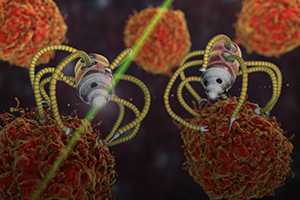DNA Origami

Researchers have successfully demonstrated the use of nanorobots to seek out and shrink cancer tumors without harming healthy cells. They do so by delivering a molecular payload that cuts off the blood supply feeding tumor growth, effectively starving the tumor.
The nanorobots were made from flat, rectangular DNA “sheets” measuring 90 by 60 nanometers. Thrombin, a blood clotting enzyme, was attached to the surface and the DNA was the “folded” to form a hollow tube about 1/1000th the diameter of a human hair. In order to make the nanorobots selective for cancer cells, a special cell called a DNA aptamer was attached to the outside of the tubes. The aptamer targets a protein called nucleolin that is only present on the surface of endothelial tumor cells.
In testing on melanoma in mice, the nanorobots were injected with an IV. In a matter of hours, they surrounded the tumor and released the thrombin like a Trojan horse. Tumor tissue damage was evident within 24 hours and ultimately the median survival time of the mice more than doubled. Furthermore, the nanorobots caused no detectable changes in normal cells and showed no evidence of spreading to the brain where stroke or other unwanted side effects could occur.
If testing continues to produce positive results, the collaborators estimated that nanorobots could be available clinically within five years.
For information: Hao Yan, Arizona State University, Biodesign Center for Molecular Design and Biomimetics, 797 East Tyler Street, Tempe, AZ 85281; phone: 480-727-8570; email: hao.yan@asu.edu; Web site: https://www.asu.edu/ or https://asunow.asu.edu/20180212-discoveries-cancer-fighting-nanorobots-seek-and-destroy-tumors